After a walk at Wahkeena Nature Preserve, Bob and I stopped to chat with Robyn. Robyn is one of the naturalists at Wahkeena, and she was the original author of the Wahkeena Nature Preserve blog. Robyn asked us how our walk went. I mentioned that I had seen lots of amphibian eggs in pools of water, but I didn’t know how to tell the difference between frog eggs and salamander eggs. She offered then and there to show us the difference.
We went to a little pool and Robyn lifted up two groups of eggs from the water.
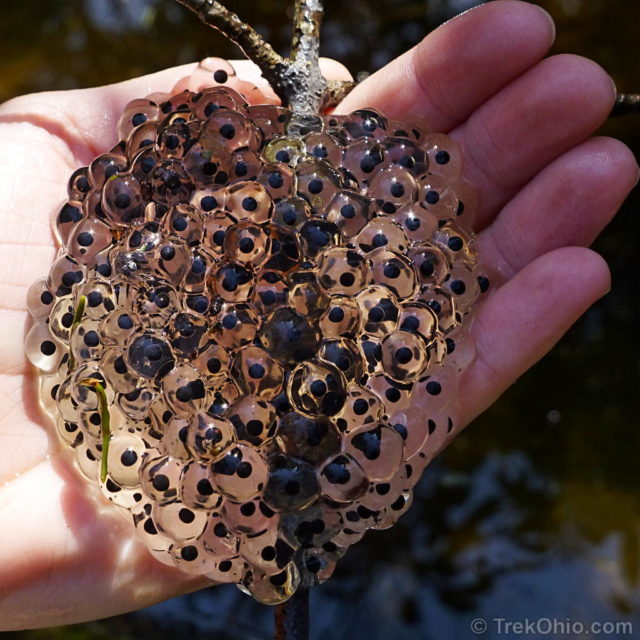

In the top photo each egg is a distinct sphere even though all the eggs are stuck together. In the second photo all of the eggs are themselves encased in a jelly. The distinct eggs in the top photo are those of the wood frog. The jelly-encased eggs in the second photo are those of the spotted salamander. Robyn invited us to touch the egg masses. I thought they might be slimy or sticky, but they weren’t at all. It felt like I was touching Jell-O.
Salamanders
In order for the entire group of salamander eggs to be in the same jelly case, they have to be laid at the same time. However when a jelly casing emerges from the female, it is much smaller than it looks in the above photo. It’s only after the jelly casing has had a chance to soak in its bath that it swells up by absorbing water.
Salamanders often lay eggs in vernal pools; these are temporary pools that form in low-lying areas in the spring. The advantage of laying eggs in a temporary pool is that fish can’t live there, so fish won’t have the opportunity to eat the salamander eggs. The disadvantage is that there is some risk that the pool will dry up before the eggs have matured. This is where the eggs’ surrounding jelly encasing comes into play. The water absorbed by the jelly casing will protect the salamander eggs from their drying surroundings. Surprisingly the jelly casing also prevents oxygen in the atmosphere from reaching the eggs. ![]() All is not lost, though. The salamander eggs exist in a symbiotic relationship with a specific algae called Oophila amblystomatis. Photosynthesizing within the jelly, these algae produce the oxygen that the salamander eggs need to develop. Through respiration the developing salamanders release carbon dioxide into the jelly which the algae use to do more photosynthesis. The role this algae plays in the life cycle of the spotted salamander is so vital that the algae exist within the body or germ cells of the salamander (a germ cell is a cell that will develop into a sperm or egg).
All is not lost, though. The salamander eggs exist in a symbiotic relationship with a specific algae called Oophila amblystomatis. Photosynthesizing within the jelly, these algae produce the oxygen that the salamander eggs need to develop. Through respiration the developing salamanders release carbon dioxide into the jelly which the algae use to do more photosynthesis. The role this algae plays in the life cycle of the spotted salamander is so vital that the algae exist within the body or germ cells of the salamander (a germ cell is a cell that will develop into a sperm or egg).
While looking into pools of water at Wahkeena, I had also noticed tiny white blobs scattered on the bottom. Here’s a photo of some that I had taken at a different location.
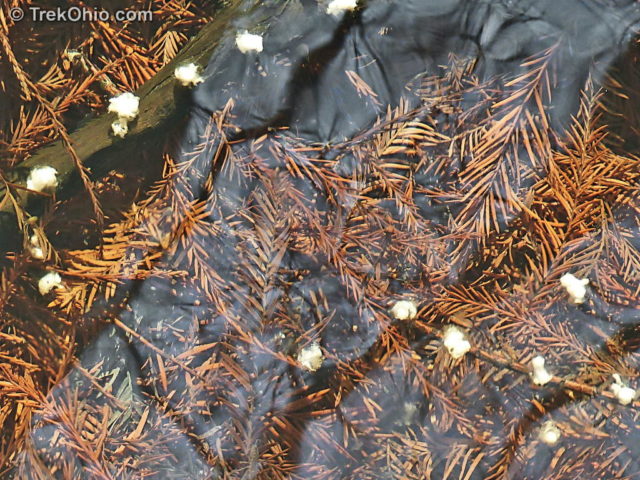
Robyn explained that these were the leftover spermatophores of male spotted salamanders. Unlike a male mammal who directly inserts his sperm into the female, male salamanders deposit their spermatophores on the floor of a breeding pool. Then during their mating ritual the male attempts to coax a female into picking up one of his spermatophores via her cloaca. I haven’t been able to photograph these salamanders myself, so I am including below a photo by Richard Bonnet.
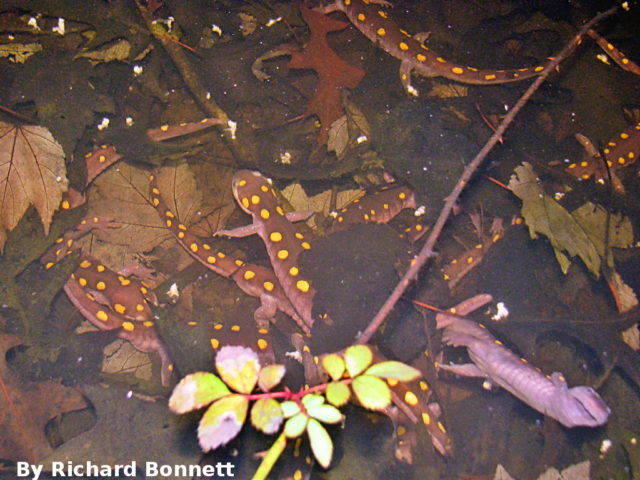
Breeding pool of spotted salamanders; the little white blobs are the male’s spermatophores.
The salamanders’ offspring look a lot like tadpoles. Here’s a photo of one that has just emerged from the encasing jelly, published by Brian Gratwickle. At this stage it is called a larva.
The larvae take two to four months to turn into juvenile salamanders. The juvenile salamanders no longer have external gills, and they leave their vernal pool and head out into the forests. An adult spotted salamander can live up to 32 years, returning every year to breed in the same vernal pool where it was born.
Frogs
Returning to wood frogs whose eggs were shown in the topmost photo, I mentioned to Robyn that I had photographed some wood frogs mating last year; I had been surprised at how orange the female had been. Robyn said that she also had observed a lot of reddish females. The photo below was taken at Dawes Arboretum. You can see a mass of wood frog eggs in the lower left.
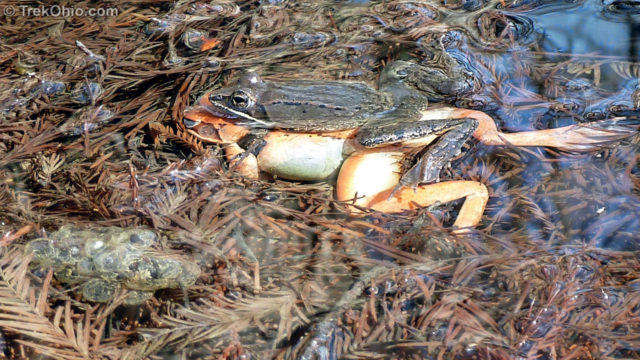
While we were looking at amphibian eggs, Robyn asked us to be quiet and listen a moment. We heard what sounded an awful lot like ducks quacking. Robyn explained that this sound was really wood frogs croaking. It was surprising how duck-like they sounded.
I mentioned to Robyn that I had been surprised to see tadpoles in a central Ohio pond as early as late winter. Robyn explained that there are two species of frog in Ohio who overwinter as tadpoles before transforming into frogs: the bullfrog and the northern green frog. Most other species of frog experience this transformation before their first winter sets in.
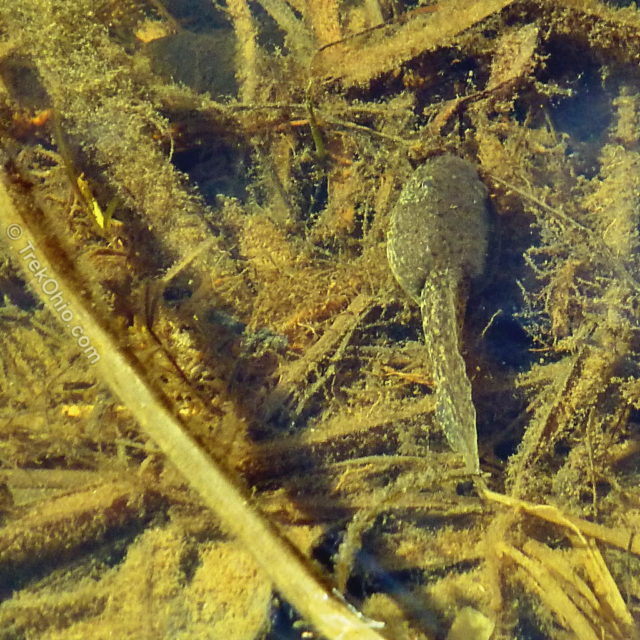
The adult form of these two species of frog can be tricky to tell a part. The key thing to look for is a ridge line the starts near each ear of the frog and goes down both sides of the back. If the ridge is present, it is a northern green frog. If it is absent, it is a bullfrog.
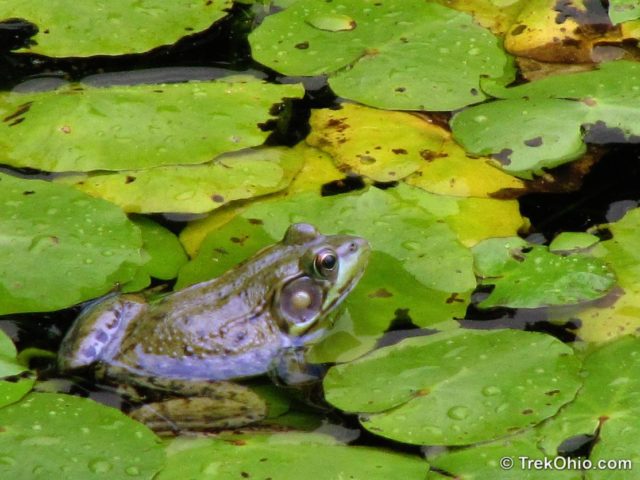
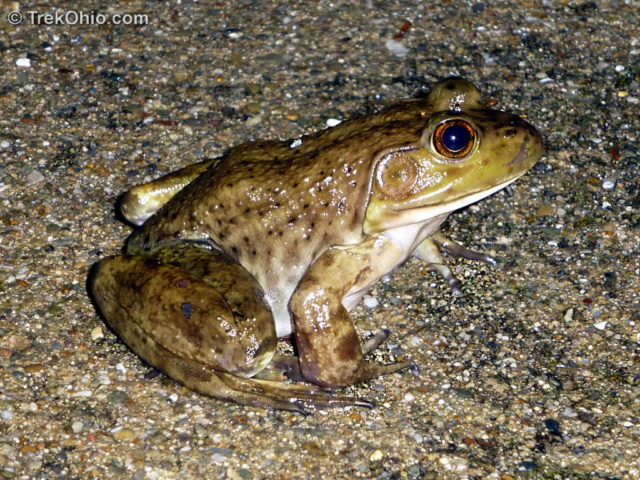
If you decide to go to Wahkeena Nature Preserve, stop by and say “hi” to the staff. If you have any nature-related questions, the on-site naturalists are both knowledgeable and willing to help. Most of what I have posted here is thanks to Robyn sharing her knowledge with me.
Additional information
- TrekOhio.com: Wahkeena Nature Preserve — General overview of this park and how to get there.
- TrekOhio.com: Ohio’s 15 species of frogs and toads at a glance — This post includes information to help you identify species.
- ODNR: Wood Frog – Lithobates sylvatica
- ODNR: Spotted Salamander – Ambystoma maculatum
- Amphibians and Reptiles of North Carolina: Spotted Salamander
- Wikipedia: Spotted salamander
- Wikipedia: Spermatophore
More on Amphibians and Reptiles
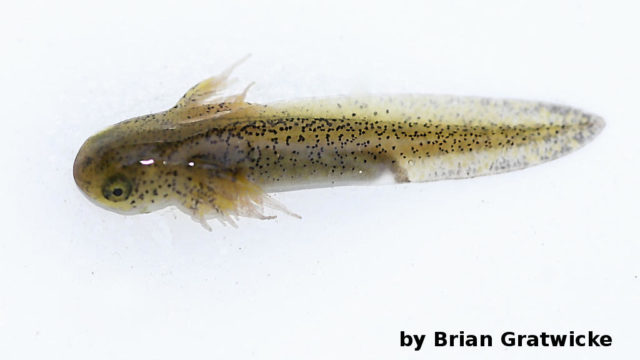
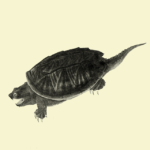
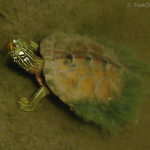
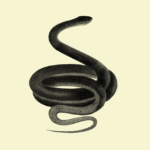
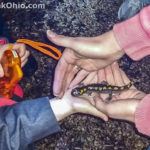
I loved to read Your post and seeing those great photos. I admire how much You know about nature’s wonders. When I was young I also followed how frog spawn and how it turned into frogs.
Fascinating!! Thanks so much…. And those images are just perfect, so incredibly lovely!
32 years… Now there’s a lesson.
Thank you, FeyGirl. 🙂
Great captures! I didn’t know eggs of frogs and salamanders looked that wonderful 🙂
Thanks, marviiilous. I was surprised at how clear the liquid in the eggs were.
Fascinating! Can’t wait to go look and see if I can find any around here.
Thanks, Sally.
I’d wondered why the salamander egg mass absorbed so much water after they were deposited. My first thought was osmosis. Turns out that’s the cause – the membranes of the salamander egg mass is semi-permeable. The vernal pool is hypotonic – that is more dilute with respect to the egg mass, so water from the pool flows through the exterior membrane increasing it’s volume. Here’s a link to a paper from Arkansas State University – the first paragraph describe multiple rings of osmotic membranes within the egg mass.
Bob, thanks for the additional information on how the salamander eggs can absorb so much water. 🙂
Really interesting–I had never heard about the algae-oxygen-salamander-carbon dioxide relationship before. We’ve enjoyed meeting Robyn too–she’s so nice and helpful!
I’ll have to be on the lookout for egg masses–I’m not sure I’ve ever seen salamander eggs but now I know what to look for!
Thanks, Deb. Robyn has been so helpful every time we’ve visited. Now that I can recognize the salamander eggs, I’d love to see the larvae myself… or even the salamanders. I have see newts many times, but never the spotted salamander. It sounds like the best time to see them is in the evening in the early spring after a rain. Apparently that encourages them to migrate to their breeding pool.
…. Interesting nature lesson. And now I have a question. If the salamander lives that long, and always returns to the same vernal pond each year — well, what happens if that temporary pond isn’t there anymore? Will any “pond in a storm” do?
“Any pond in a storm” <– LOL. But it is a good question. It seems like it wouldn't be very adaptive if the animals can't go to a different pond if their ancestral pond is dry, filled in, or whatever. But if it is only temporarily dry, imagine the confusion the following year. Does it go to the new pond it tried the previous year, or does it revert to its ancestral pond?
This is a subject I knew very little about. Thank you for the excellent post.
Your welcome, Patricia.